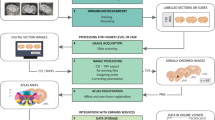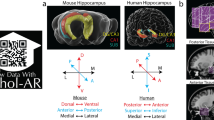Abstract
The fimbria is a major route for afferent and efferent fibers of the hippocampal formation. However, little is known about the intrinsic organization of the fimbria-fornix complex. In this study, the anterograde tracer Phaseolus vulgaris-leucoagglutinin (PHAL) was used to analyze the ultrastructure and topography of identified fiber tracts within the fimbria-fornix. Septo-hippocampal fibers are loosely distributed throughout the fimbria-fornix. Commissural fibers cross the midline in the ventral hippocampal commissure and form a tight fiber bundle in the fimbria. Crossed entorhino-hippocampal fibers cross the midline in the ventral hippocampal commissure rostral to the commissural fiber bundle, and crossed entorhino-entorhinal fibers pass through the dorsal hippocampal commissure. This suggests a topographical organization of fiber tracts within the fimbria-fornix that reflects the laminar organization of the hippocampal target structure: fibers of the diffusely terminating septohippocampal projection are loosely distributed throughout the fimbria-fornix, while those projections that are known to terminate in specific laminae of the hippocampal formation (commissural projection, crossed entorhino-hippocampal projection) form fiber bundles within the fimbria and the ventral hippocampal commissure.
Similar content being viewed by others
Abbreviations
- A :
-
Astrocyte
- CA1, CA3 :
-
hippocampal subfields
- CC :
-
corpus callosum
- D :
-
dendrite
- DG :
-
dentate gyrus
- DHC :
-
dorsal hippocampal commissure
- Fi :
-
fimbria
- LS :
-
lateral septal area
- LV :
-
lateral ventricle
- O :
-
oligodendrocyte
- SFO :
-
subfornical organ
- VHC :
-
ventral hippocampal commissure
References
Alonso A, Köhler C (1982) Evidence for separate projections of hippocampal pyramidal and non-pyramidal neurons to different parts of the septum in the rat brain. Neurosci Lett 31:209–214
Amaral DG, Witter MP (1995) The hippocampal formation. In: Paxinos G (ed) The rat nervous system, 2nd edn. Academic Press, New York London, pp 443–494
Brook GA, Lawrence JM, Raisman G (1993) Morphology and migration of cultured Schwann cells transplanted into the fimbria and hippocampus in adult rats. Glia 9:292–304
Buchan AM, Pulsinelli WA (1990) Septo-hippocampal deafferentation protects CA1 neurons against ischemic injury. Brain Res 512(1):7–14
Deller T, Leranth C (1990) Synaptic connections of NPY-immunoreactive neurons in the rat hilar area. J Comp Neurol 300:433–447
Deller T, Nitsch R (1995) Selective rostral transection of the fornix spares the hippocampal commissural pathway in the rat: a Phaseolus vulgaris-leucoagglutinin-tracing study. Exp Brain Res 104:243–248
Deller T, Nitsch R, Frotscher M (1994) Associational and commissural afferents of parvalbumin-immunoreactive neurons in the rat hippocampus: a combined immunocytochemical and PHAL study. J Comp Neurol 350:612–622
Deller T, Nitsch R, Frotscher M (1995) Phaseolus vulgaris-leucoagglutinin (PHAL) tracing of commissural fibers to the rat fascia dentata: evidence for a previously unknown commissural projection to the outer molecular layer. J Comp Neurol 352:55–68
Deller T, Frotscher M, Nitsch R (1996) Sprouting of crossed entorhino-dentate fibers after a unilateral entorhinal lesions: anterograde tracing of fiber reorganization with Phaseolus vulgaris leucoagglutinin (PHAL). J Comp Neurol (in press)
Dutar P, Lamour Y, Rascol O, Jobert A (1986) Septo-hippocampal neurons in the rat: further study of their physiological and pharmacological properties. Brain Res 365:325–334
Finnerty GT, Jefferys JGR (1993) Functional connectivity from CA3 to the ipsilateral and contralateral CA1 in the rat dorsal hippocampus. Neuroscience 56:101–108
Freund TF, Antal M (1988) GABA-containing neurons in the septum control inhibitory interneurons in the hippocampus. Nature 336:170–173
Frotscher M (1988) Neuronal elements in the hippocampus and their synaptic connections. In: Frotscher M, Kugler P, Misgeld U, Zilles K (eds) Neurotransmission in the hippocampus. Adv Anat Embryol Cell Biol 111:2–19
Frotscher M (1991) Target cell specificity of synaptic connections in the hippocampus. Hippocampus 1:123–130
Frotscher M (1992) Specificity of interneuronal connections. Ann Anat 174:377–382
Frotscher M, Zimmer J (1983) Commissural fibers terminate on non-pyramidal neurons in the guinea pig hippocampus — a combined Golgi/EM degeneration study. Brain Res 265:289–293
Gaykema RPA, Kuil J van der, Hersh LB, Luiten PGM (1991) Patterns of direct projections from the hippocampus to the medial septum-diagonal band complex: anterograde tracing with Phaseolus vulgaris leucoagglutinin combined with immunocytochemistry of choline acetyltransferase. Neuroscience 43:349–360
Gerfen CR, Sawchenko PE (1984) An anterograde neuroanatomical tracing method that shows the detailed morphology of neurons, their axons and terminals: immunohistochemical localization of an axonally transported plant lectin, Phaseolus vulgaris leucoagglutinin. Brain Res 290:219–238
Koliatsos VE, Applegate MD, Kitt CA, Walker LC, DeLong MR, Price DL (1989) Aberrant phosphorylation of neurofilaments accompanies transmitter-related changes in rat septal neurons following transection of the fimbria-fornix. Brain Res 482:205–218
Lamour Y, Dutar P, Jobert A (1984) Septo-hippocampal and other medial septum-diagonal band neurons: electrophysiological and pharmacological properties. Brain Res 309:227–239
Leranth C, Frotscher M (1983) Commissural afferents to the rat hippocampus terminate on vasoactive intestinal polypeptidelike immunoreactive non-pyramidal neurons. An EM and immunocytochemical degeneration study. Brain Res 276:357–361
Li YJ, Simon JR, Low WC (1992) Intrahippocampal grafts of cholinergic-rich striatal tissue ameliorate spatial memory deficits in rats with fornix lesions. Brain Res Bull 29:147–155
Naumann T, Peterson GM, Frotscher M (1992) Fine structure of rat septohippocampal neurons: II. A time course analysis following axotomy. J Comp Neurol 325:219–242
Nyakas C, Luiten PGM, Spencer DG, Traber J (1987) Detailed projection patterns of septal and diagonal band efferents to the hippocampus in the rat with emphasis on innervation of CA1 and dentate gyrus. Brain Res Bull 18:533–545
Paxinos G, Watson C (1986) The rat brain in stereotaxic coordinates, 2nd edition. Academic Press, New York London
Raisman G (1969) Neuronal plasticity in the septal nuclei of the adult rat. Brain Res 14:25–48
Raisman G, Field PM (1973) A quantitative investigation of the development of collateral reinnervation after partial deafferentiation of the septal nuclei. Brain Res 50:241–264
Raisman G, Lawrence JM, Brook GA (1993) Schwann cells transplanted into the CNS. Int J Dev Neurosci 11:651–669
Seress L, Ribak CE (1984) Direct commissural connections to basket cells of the hippocampal dentate gyrus: anatomical evidence for feed-forward inhibition. J Neurocytol 13:215–225
Steward O (1976) Topographic organization of the projections from the entorhinal area to the hippocampal formation of the rat. J Comp Neurol 167:285–314
Steward O, Scoville SA (1976) Cells of origin of entorhinal cortical afferents to the hippocampus and fascia dentata of the rat. J Comp Neurol 169:347–370
Suzuki M, Raisman G (1992) The glial framework of central white matter tracts: segmented rows of contiguous interfascicular oligodendrocytes and solitary astrocytes give rise to a continuous meshwork of transverse and longitudinal processes in the adult rat fimbria. Glia 6:222–235
Suzuki M, Raisman G (1994) Multifocal pattern of postnatal development of the macroglial framework of the rat fimbria. Glia 12:294–308
Swanson LW, Wyss JM, Cowan WM (1978) An autoradiographic study of the organization of intrahippocampal association pathways in the rat. J Comp Neurol 181:681–716
Swanson LW, Sawchenko PE, Cowan WM (1980) Evidence that the commissural, associational and septal projections of the regio inferior of the hippocampus arise from the same neurons. Brain Res 197:207–212
Wyss JM (1981) An autoradiographic study of the efferent connections of the entorhinal cortex in the rat. J Comp Neurol 199:495–512
Wyss JM, Swanson LW, Cowan WM (1980) The organization of the fimbria, dorsal fornix and ventral hippocampal commissure in the rat. Anat Embryol 158:303–316
Author information
Authors and Affiliations
Rights and permissions
About this article
Cite this article
Adelmann, G., Deller, T. & Frotscher, M. Organization of identified fiber tracts in the rat fimbria-fornix: an anterograde tracing and electron microscopic study. Anat Embryol 193, 481–493 (1996). https://doi.org/10.1007/BF00185879
Accepted:
Issue Date:
DOI: https://doi.org/10.1007/BF00185879




